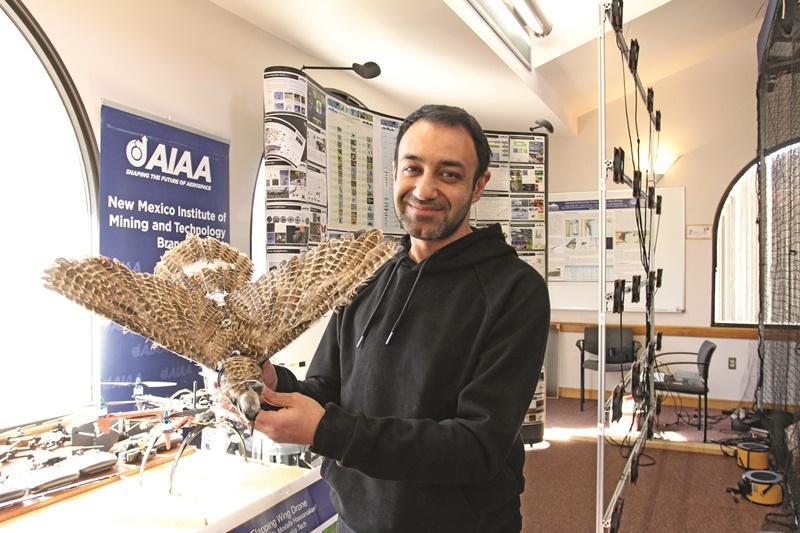Welcome back to Excavating Innovation, a new bi-monthly interview series showcasing the visionaries and trailblazers who call Space Valley home. This week, we’re excited to feature Dr. Mostafa Hassanalian, a mechanical engineer, drone researcher, and professor at New Mexico Tech, whose pioneering work in biomimetics and bio-inspiration is transforming the future of aerospace and planetary exploration.
Mostafa is part scientist, part inventor, and part educator. He fuses a passion for nature with an unrelenting drive to push drone technology far beyond its conventional limits. From designing insect-sized flapping machines to spearheading swarm robotics on other planets, he has dedicated the last decade of his career in New Mexico to decoding the secrets of flight found in birds, insects, and even dandelion seeds. Ultimately, his vision transcends Earth’s boundaries, as he develops drone and robotic concepts that could one day roll across Martian deserts or dive into the liquid methane seas of Saturn’s moon Titan.
Check out our full conversation with Dr. Hassanalian below. We dive into how he arrived in the Land of Enchantment, how the region’s open skies and natural wonders shaped his research, and why he believes New Mexico can become a global hub for drone innovation.
New Mexico is known for its stunning landscapes and research-friendly environment. What brought you here, and how did it shape your path in drone technology?
Dr. Hassanalian: I moved to New Mexico about ten years ago to pursue my PhD in mechanical engineering at New Mexico State University. My background was already in flapping-wing micro aerial vehicles—bird- or insect-sized drones—but New Mexico’s unique mix of wide-open skies, diverse wildlife, and top-tier research institutions propelled my work in an entirely new way. After completing my PhD in just three years, I joined New Mexico Tech, where I’ve spent the last seven years integrating lessons from nature into drones and robotics. The clear skies, the Bosque del Apache with its amazing migratory birds, and the state’s overall enthusiasm for aerospace research have been game-changers for me.
You often mention two concepts—biomimetics and bio-inspiration. How do they differ, and why do they matter for drones?
Dr. Hassanalian: Biomimetics is about replicating nature as closely as possible. Like copying a bird’s exact wing motions for a flapping drone. Bio-inspiration, on the other hand, means taking cues from nature without replicating every detail. A classic example: airplanes. We borrowed the principle of winged flight from birds, but you don’t see planes flapping around! Whether I’m studying butterfly coloration or the rolling behavior of desert spiders, the ultimate goal is to blend efficiency, maneuverability, and sustainability into new drone concepts.
Many of your projects go beyond traditional quadcopters. Like rolling “pill-bug” robots, jumping grasshopper rovers, even dandelion-seed-sized probes. What drives these designs?
Dr. Hassanalian: Nature offers endless templates for movement and survival. On Mars, for instance, a wheeled rover may struggle on rocky terrain. Inspired by the golden-wheel spider and grasshoppers, we’re building rovers that roll or hop, potentially harnessing wind for longer, faster exploration. For Titan, Saturn’s moon with its liquid methane seas, we proposed a drone that “refuels” using Titan’s atmospheric and surface resources—mimicking how birds harness thermals on Earth. Even dandelion seeds taught us how to create ultra-light micro drones that can float long distances while gathering sensor data.
We’ve heard you’re exploring how feather pigmentation impacts flight. That sounds almost artistic!
Dr. Hassanalian: It’s a fantastic intersection of art and science. Migratory birds often have darker feathers on top, lighter underneath, creating temperature differentials that increase aerodynamic efficiency. We discovered that even subtle color changes can alter lift-to-drag ratios, potentially saving fuel. Monarch butterflies have black, orange, and white sections on their wings—those color patches help regulate body temperature and airflow. These findings might translate to more efficient aircraft or drones, all thanks to nature’s ingenious palette.
Beyond planetary exploration, you’re also working in subterranean and urban environments. Can you share an example?
Dr. Hassanalian: Yes! We developed an intrinsically safe drone for coal mines, where methane gas poses explosive risks. By enclosing all electronics and using magnetic couplers, we minimized ignition hazards, making underground exploration safer. Another exciting project involves self-sustaining “drone nests” in cities, inspired by bird nests or honeybee hives. Imagine drones monitoring air quality or delivering urgent supplies, docking autonomously to recharge and gather data, just as birds return to the nest.
Tell us a bit about your educational outreach. It sounds like you’re keen to inspire younger generations.
Dr. Hassanalian: I run summer camps and workshops where middle- and high-schoolers build and fly drones in just a few days. We also develop drone curriculums for teachers, showing them how to blend science, technology, engineering, math—and even art—into hands-on lessons. So far, hundreds of students and dozens of teachers have gone through these programs. Some students end up co-authoring research papers or winning robotics competitions. Watching them fall in love with flight and engineering is one of the most rewarding parts of my job.
Any upcoming projects you’re excited about?
Dr. Hassanalian: We’re refining our micro dandelion-drone concept for planetary caves and lava tubes—particularly on Mars. Picture thousands of tiny flyers floating on Martian winds, transmitting temperature, radiation, and chemical readings back in real time. Plus, we’re exploring color-based airflow manipulation on larger unmanned vehicles. Essentially, we’re using nature’s “paintbrush” to see if we can cut energy costs and increase flight endurance.
Dr. Hassanalian’s passion for bio-inspiration and commitment to educational outreach embody the spirit of Space Valley—a place where cutting-edge research, cultural exploration, and a little desert magic intersect under the bright New Mexico sky. Whether he’s equipping a coal mine rover to detect methane or developing next-gen drones capable of rolling across Martian terrain, Dr. Hassanalian continues to push boundaries for what’s possible in aerospace.
Stay tuned for more Spotlights on extraordinary innovators who are redefining the limits of art, science, and technology. For upcoming events or to connect with fellow explorers, researchers, and creatives, visit SpaceValley.org.

